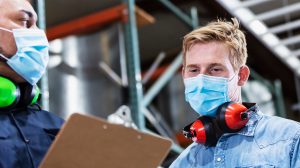June 9, 2021
Your internet browser isn't supported.
Five Ways COVID-19 Has Changed Warehousing and Distribution
With the arrival of COVID-19, the logistics industry faced an unprecedented stress test as consumer spending habits changed drastically while supply chain disruptions multiplied. Warehousing and distribution companies had to quickly adapt and pivot to address everything from worker safety concerns to space shortages.
Now that a return to normalcy seems on the horizon, experts believe that many warehousing and distribution trends spurred by COVID-19 are here to stay. Here are some of them.
#1 - Increased investments in safety and sanitation.
Industrial workspaces haven’t historically been conducive to physical distancing, as companies sought to get as much done in as little space as possible. Deemed “essential businesses” allowed to continue in-person operations amid the pandemic, facilities like food processing plants began to see coronavirus outbreaks among their workers (who demanded better working conditions).
It remains to be seen which COVID-19 workplace standards OSHA might implement at the federal level, but many facilities have adjusted day-to-day operations to allow for distancing, contact tracing, and the use of technology like digital inventory tracking systems to limit contact.
Did you know: Many businesses are using smart lighting sensors to promote safe occupancy levels. Technology like real-time location systems (RTLS) can be used to track both people and assets as they move throughout a building, which is useful for contact tracing.
#2 - Sanitation is top-of-mind and will be for the foreseeable future.
Sanitization has been a key tactic for essential businesses looking to protect their employees and customers. Warehouses everywhere have increased cleaning frequency, implemented new disinfection protocols, and looked to improve ventilation.
This focus on sanitation won’t likely disappear anytime soon since it appears unlikely that the coronavirus will be eradicated in the foreseeable future.
Did you know: Lighting can be a key tool in keeping facilities sanitary, helping crews spot problem areas better. Real-time location systems are even used by healthcare and other facilities to facilitate hand hygiene.
#3 - Explosive eCommerce growth (that isn’t slowing down).
Consumers turned to contactless shopping during the pandemic, leading to record eCommerce sales; in 2020, eCommerce sales grew by 32% in the U.S. That upward trend will likely continue, as more consumers who began buying online out of necessity continue that habit for the sake of convenience. In a Wunderman Thompson study, nearly 40% of consumers said they were more comfortable with digital technology than they were before the lockdown.
This has left businesses scrambling for more warehouses, gobbling up industrial space, and even getting creative with what types of real estate spaces can be repurposed as warehouses—from vacant department stores and malls to office buildings. Amazon recently built a $350M distribution center on top of a shuttered golf course in New York.
Did you know: With retrofits on the rise (to convert vacant spaces into warehouse space), lighting can be the key to ensuring safety and productivity.
#4 - More demand for cold storage solutions.
With fewer people dining at restaurants and more households anxious to keep their freezers fully stocked, cold storage sales volume rose 22% in 2020. By comparison, commercial real estate as a whole plummeted 29%.
Although cold storage will continue to be a hot commodity, building new facilities isn’t an easy or inexpensive undertaking. Construction of cold storage buildings costs 2-3X more than dry warehouses, and the process can take months longer. Because of the complexity and cost associated with building and operating these facilities, experts predict to see a wave of innovation and automation, and potential consolidation of the major players.
Did you know: A key component in cold storage facilities is lighting that is specifically designed and tested to withstand extreme temperatures. Industrial fixtures that are classified as “vaportite” can even stand up to pressure washing.
#5 - Heightened focus on last-mile distribution.
Consumers have increasingly high expectations around how fast products will arrive, as well as the entire customer experience as a whole. When COVID-19 put additional pressure on businesses to get faster and more efficient, many moved to decentralize their warehouse space to get products closer to customers’ homes.
Pop-up distribution centers (or micro fulfillment centers), long used during the holiday season, emerged as an even more common way to route orders more effectively and shorten fulfillment times. Because of their smaller footprint, micro fulfillment centers remain an attractive option to get products closer to residents of populous cities.
Did you know: Even smaller “micro” fulfillment centers could still benefit from a smart lighting strategy to help with safety and alertness and reduce picking errors.

